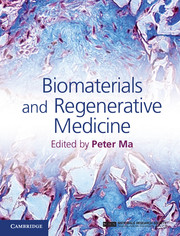Book contents
- Frontmatter
- Contents
- List of contributors
- Preface
- Part I Introduction to stem cells and regenerative medicine
- Part II Porous scaffolds for regenerative medicine
- Part III Hydrogel scaffolds for regenerative medicine
- Part IV Biological factor delivery
- Part V Animal models and clinical applications
- 25 Bone regeneration
- 26 Biomaterials for engineered tendon regeneration
- 27 Advancing articular cartilage repair through tissue engineering: from materials and cells to clinical translation
- 28 Engineering tissue-to-tissue interfaces
- 29 Models of composite bone and soft-tissue limb trauma
- 30 Tooth development and regeneration
- 31 Dentin–pulp tissue engineering and regeneration
- 32 Dental enamel regeneration
- 33 Hair follicle and skin regeneration
- 34 In-vitro blood vessel regeneration
- 35 Stem cells for vascular engineering
- 36 Cardiac tissue regeneration in bioreactors
- 37 Bladder regeneration
- Index
- References
37 - Bladder regeneration
from Part V - Animal models and clinical applications
Published online by Cambridge University Press: 05 February 2015
- Frontmatter
- Contents
- List of contributors
- Preface
- Part I Introduction to stem cells and regenerative medicine
- Part II Porous scaffolds for regenerative medicine
- Part III Hydrogel scaffolds for regenerative medicine
- Part IV Biological factor delivery
- Part V Animal models and clinical applications
- 25 Bone regeneration
- 26 Biomaterials for engineered tendon regeneration
- 27 Advancing articular cartilage repair through tissue engineering: from materials and cells to clinical translation
- 28 Engineering tissue-to-tissue interfaces
- 29 Models of composite bone and soft-tissue limb trauma
- 30 Tooth development and regeneration
- 31 Dentin–pulp tissue engineering and regeneration
- 32 Dental enamel regeneration
- 33 Hair follicle and skin regeneration
- 34 In-vitro blood vessel regeneration
- 35 Stem cells for vascular engineering
- 36 Cardiac tissue regeneration in bioreactors
- 37 Bladder regeneration
- Index
- References
Summary
Introduction
Bladder tissue engineering technology has provided an alternative treatment for patients with congenital bladder conditions (e.g. bladder exstrophy) and conditions such as radiation damage, infection, interstitial cystitis, neuropathic small bladder disease, and bladder cancer. To treat these end-stage bladder diseases, a partial or total cystectomy is often performed, followed by the creation of a neobladder or a continent urinary reservoir using intestinal segments to restore bladder capacity. However, using bowel tissue for this purpose may cause many side effects, although a recent study showed that all children with neurogenic bladder disease are at increased risk of bladder cancer regardless of exposure to intestinal tissue in the urinary tract [1]. Therefore, new clinical and surgical techniques are needed in order to allow these patients to live healthier and more normal lives. The authors of a clinical study recently reported that it is possible to engineer neo-bladder tissue using autologous cells seeded on biodegradable scaffolds [2] and that this engineered tissue can be used to enlarge the bladder volume and improve function for patients with neuropathic diseases. Additionally, increasing evidence indicates that the use of patients’ own stem cells provides a promising alternative for patients with end-stage bladder diseases in cases in which healthy autologous bladder cells might not be available.
- Type
- Chapter
- Information
- Biomaterials and Regenerative Medicine , pp. 669 - 679Publisher: Cambridge University PressPrint publication year: 2014
References
- 2
- Cited by

